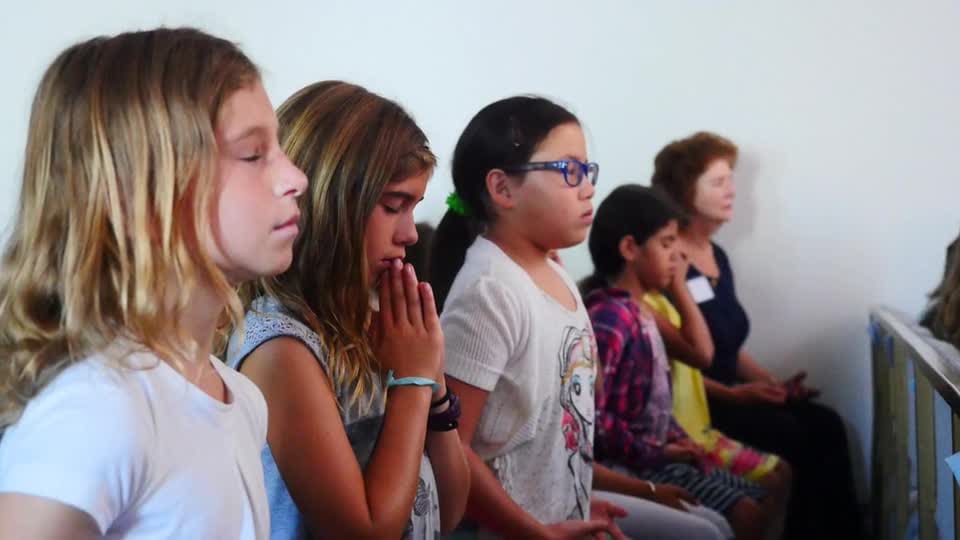Teach Meditation to Children

Following excerpts are from an article, “Meditating with Children”, written by Patricia Evertz and published in SRF YSS magazine.
A longtime member of SRF, Patricia Evertz is an educational psychologist and has served for nearly 30 years in the SRF Sunday school program.
Keep it simple. Paramahansa Yogananda often commented that God is as close to you as your thought allows Him to be. A sincere prayer and a few moments of silence can be all that is needed to bring God into a child’s life. Prayers do not need to be long or sophisticated. A heartfelt prayer like, “Come to me,” or “Fill me with Your love,” can be enough to draw God’s response. Children do not need to understand the entire science of yoga to meditate effectively. Simple techniques such as visualization exercises or singing a chant with deeper and deeper at-tention, can work very effectively for them.
Begin where they are. Consider what motivates your child… For instance, if your daughter has a special friend at school she is very close to, you can point out that her feelings for her friend are a little bit of God’s love. In meditation have her focus on her feelings for her friend and then have her try to feel that same love for God. You can also practice a visualization exercise with her to expand her love, beginning with feeling and sending love to her friends and family, then neighbours and city, and finally to all in the world.
If your child is into sports, explain how focusing attention at the point between the eyebrows develops will power. Help children understand how meditation will help them in their daily lives.
Use language and techniques that are age-appropriate. Use language that your children understand, and explain terms they don’t know. Suppose you begin your meditation with one of Paramahansa Yogananda’s chants, “Listen, Listen, Listen.” (The words to this chant are, “Listen, listen, listen to my heart’s song. I will never forget Thee; I will never forsake Thee.”) Explain what “forsake” means. Ask very young children, “Who is meant when we say ‘Thee’?” Have them put in their own words what the chant means. Then chant together from your hearts, first in a voice of normal intonation, then softer and more softly until chanting mentally, “whispering the words in our hearts where only God can hear us.” (You need not know how to play the harmonium to chant with your children. Try chanting a capella, or use a tape of SRF monks or nuns chanting.) Likewise, if you lead your children in an affirmation, check their understanding before they practice. For instance, if you use the affirmation, “I am safe in the fortress of Thy presence,” make sure your children understand the meaning of “fortress.” Point out how strong and powerful a fortress is, and how God’s protection, though invisible, is actually stronger than any fortress. Then repeat the affirmation as you would the chant, first in normal intonation, then softer and softer until you are mentally chanting it together. For teens, there are several meditations in Metaphysical Meditations you can use verbatim, but discuss words like “myriad,” “all-pervading,” and “emancipation” that appear in some of the passages. Visualization exercises, chanting, affirmations, and the Healing Technique (given in the SRF Worldwide Prayer Circle booklet), can all be practiced effectively by children.
Encourage, but don’t push: Expose your children to meditation, and see how they respond. Some may enjoy it and perhaps do it often; others may not be ready. Bear in mind that if they don’t show an interest in meditation at this time, they may in the future. They will be more receptive later on if they are not forced to meditate before they are ready…
If your children don’t want to do it on a daily basis, see if they are interested in having a weekly family meditation. Keep meditations short, and involve the children, allowing them to participate in leading the prayers or playing simple instruments for a family kirtan.
Keep meditations brief. In the SRF Sunday school program we have generally found the following lengths work best for children’s attention spans:
Ages 3–5 1-3 minutes Ages 6–8 3-5 minutes Ages 9-12 5 minutes to start with… Ages 13-15 5-10 minutes to start with… The meditations are not only periods of silence. They include prayers and talking the child through the meditation, including such elements as a chant, affirmation, or visualization, or praying for others.
Selected Parenting Tips
Teach Meditation to your Child Loving Discipline Loving Communication “How to live” education Don’t force Spirituality on kids Spiritual Stories Spiritual Activities SRF YSS Parenting Literature